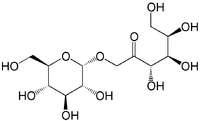Trehalulose
Trehalulose is a disaccharide made up of a molecule of fructose bound to a molecule of glucose. Like isomaltulose, it is a structural isomer of sucrose that is present in small quantities in honey.[1] It makes up 50% of sugars in the honeydew of silverleaf whiteflies[2][3] and is synthesised from sucrose by some bacteria,[4][5] such as Protaminombacter rubrum.[6][1] Because the anomeric carbon of the fructose moiety is not involved in the glycosidic bond, it is a reducing sugar.[6]
 | |
| Names | |
|---|---|
| IUPAC name
1-O-α-D-Glucopyranosyl-D-fructose | |
| Identifiers | |
3D model (JSmol) |
|
| ChEBI | |
| ChemSpider | |
| ECHA InfoCard | 100.051.967 |
| EC Number |
|
| KEGG | |
PubChem CID |
|
| UNII | |
CompTox Dashboard (EPA) |
|
| |
| |
| Properties | |
| C12H22O11 | |
| Molar mass | 342.297 g·mol−1 |
Except where otherwise noted, data are given for materials in their standard state (at 25 °C [77 °F], 100 kPa). | |
| Infobox references | |
Physiology
Because the fructose and glucose molecules are linked by a 1,1 glycosidic bond, which is more stable than the 1,2 glycosidic bond in sucrose, it is broken down more slowly than sucrose in the small intestine.[6] This more stable bond also means that it cannot be utilised by streptococcus mutans, and it is therefore non-cariogenic.[7]
Properties
Unlike isomaltulose, trehalulose strongly resists crystallisation, and forms an amorphous solid when dried. Its sweetness relative to sucrose has been estimated as between 0.4[8] and 0.7.[9]
It has a specific rotation of °.[1]
Honey from stingless bees
In 2020 researchers at the University of Queensland found that some species of stingless bee in Australia, Malaysia, and Brazil produce honey that has trehalulose with a low glycaemic index (GI) rather than the usual glucose and fructose. This beneficial for health because blood sugar level does not rise quickly. It is also beneficial as it does not cause tooth decay. The university's findings supported the long-standing claims of Indigenous Australian people that native honey is beneficial for human health.[10][11]
References
- Wolfgang Gerhartz, ed. (1994). Ullmann's encyclopedia of industrial chemistry / Vol. A. Alphabetically arranged articles. 25, Starch and other polysaccharides to surfactants (5., completely rev ed.). Weinheim: VCH Verl.-Ges. pp. 426–427. ISBN 3-527-20125-4. OCLC 311987978.
- Salvucci, Michael E.; Wolfe, Gregory R.; Hendrix, Donald L. (1997-05-01). "Effect of sucrose concentration on carbohydrate metabolism in Bemisia argentifolii: Biochemical mechanism and physiological role for trehalulose synthesis in the silverleaf whitefly". Journal of Insect Physiology. 43 (5): 457–464. doi:10.1016/S0022-1910(96)00124-2. ISSN 0022-1910.
- Dictionary of carbohydrates with CD-ROM. Collins, P. M., (2nd ed.). Boca Raton. p. 538. ISBN 0-8493-7765-X. OCLC 70262506.CS1 maint: extra punctuation (link) CS1 maint: others (link)
- Hamerli, Dénes; Birch, Robert G. (2011). "Transgenic expression of trehalulose synthase results in high concentrations of the sucrose isomer trehalulose in mature stems of field-grown sugarcane". Plant Biotechnology Journal. 9 (1): 32–37. doi:10.1111/j.1467-7652.2010.00528.x. ISSN 1467-7652.
- Tsuyuki, Ken'ichiro; Sugitani, Toshiaki; Miyata, Yukie; Ebashi, Tadishi; Nakajima, Yoshikazu (1992). "Isolation and characterization of isomaltulose- and trehalulose-producing bacteria from Thailand soil". The Journal of General and Applied Microbiology. 38 (5): 483–490. doi:10.2323/jgam.38.483. ISSN 1349-8037.
- Rosenplenter, Kurt; Lipinski, Prof Dr Gert-Wolfhard von Rymon; Nöhle, Prof Dr Ulrich (2007-01-01). Handbuch Süßungsmittel (in German). Behr's Verlag DE. p. 258. ISBN 978-3-89947-947-8.
- Ooshima, T.; Izumitani, A.; Minami, T.; Fujiwara, T.; Nakajima, Y.; Hamada, S. (1991). "Trehalulose Does Not Induce Dental Caries in Rats Infected with Mutans Streptococci". Caries Research. 25 (4): 277–282. doi:10.1159/000261376. ISSN 0008-6568. PMID 1913765.
- , "Process for producing a saccharide composition containing trehalulose.", issued 1997-03-03
- Ravaud, Stéphanie; Watzlawick, Hildegard; Haser, Richard; Mattes, Ralf; Aghajari, Nushin (2005-01-01). "Expression, purification, crystallization and preliminary X-ray crystallographic studies of the trehalulose synthase MutB from Pseudomonas mesoacidophila MX-45". Acta Crystallographica Section F Structural Biology and Crystallization Communications. 61 (1): 100–103. doi:10.1107/S1744309104030623. ISSN 1744-3091. PMC 1952383. PMID 16508103.
- Layt, Stuart (2020-07-23). "Scientists say native stingless bee honey hits the sweet spot". Brisbane Times. Retrieved 2020-07-27.
- Fletcher, Mary T.; Hungerford, Natasha L.; Webber, Dennis; Carpinelli de Jesus, Matheus; Zhang, Jiali; Stone, Isobella S. J.; Blanchfield, Joanne T.; Zawawi, Norhasnida (2020-07-22). "Stingless bee honey, a novel source of trehalulose: a biologically active disaccharide with health benefits". Scientific Reports. 10 (1): 1–8. doi:10.1038/s41598-020-68940-0. ISSN 2045-2322.